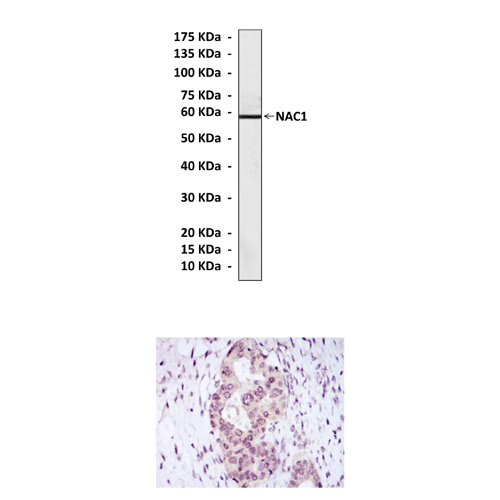Product Sheet CP10351
Description
BACKGROUND The BTB/POZ family participates in several cellular functions including proliferation, apoptosis, transcription control, and cell morphology maintenance. The BTB/POZ proteins share an evolutionally conserved BTB/POZ protein-protein interaction motif at the NH2 terminal that mediates either homodimer or heterodimer formation. Some BTB/POZ proteins mediate transcriptional repression through their ability to recruit corepressors. NAC1 is a BTB/POZ family member. Nac1 lacks a zinc-finger DNA-binding domain and thereby differs from most other POZ-domain transcription factors. NAC1 has been suggested to participate in maintaining the stemness of embryonic stem cells and has been implicated in the pathogenesis of human cancer. NAC1 is significantly overexpressed in several types of human carcinomas, where it plays a critical role in maintaining tumor cell proliferation and survival. In ovarian cancer, NAC1 upregulation is associated with disease aggressiveness and with the development of chemoresistance.1 Like other BTB/POZ proteins, NAC1 forms discrete nuclear bodies in non-dividing cells. It was shown that NAC1 was rapidly exchanged between the nucleoplasm and NAC1 nuclear bodies in interphase cells. The number of NAC1 bodies significantly increased and their size decreased in the S phase as compared to the G0/G1 and G2 phases. NAC1 nuclear bodies disappeared and NAC1 became diffuse during mitosis. NAC1 nuclear bodies reappeared immediately after completion of mitosis. Thus, a cell cycle-dependent regulatory mechanism controls NAC1 body formation in the nucleus and NAC1 body dynamics are associated with mitosis or cytokinesis.1 In central nervous system (CNS), NAC1 is increased by cocaine selectively in the nucleus accumbens, a CNS region important for drug addiction. Each of the two NAC1 isoforms, sNAC1 (short NAC1) and lNAC1 (long NAC1), may serve as corepressors for other POZ/BTB proteins. It was shown that histone deacetylase (HDAC) inhibition reversed sNAC1 and lNAC1 repression of Gal4 luciferase, but only in neuronal-like cultures. HDAC 3 and 4 both demonstrated protein–protein interactions with sNAC1 and lNAC1. Other corepressors, specifically NCoR (nuclear receptor corepressor), SMRT (silencing mediator for retinoid and thyroid hormone receptor) and mSin3a, do not exhibit protein–protein interactions with sNAC1 and lNAC1. sNAC1 and lNAC1 recruit histone deacetylases for transcriptional repression, further enhancing POZ/BTB protein mediated repression.2 Moreover, NAC1 was found to complex with proteins in the the ubiquitin-proteasome system (UPS), including cullins and Mov34. NAC1 and the proteasome were cotranslocated from the nucleus into dendritic spines in cortical neurons in response to proteasome inhibition or disinhibiting synaptic activity with bicuculline. NAC1 modulates the translocation of the UPS from the nucleus into dendritic spines, thereby suggesting a potential missing link in the recruitment of necessary proteolysis machinery for synaptic remodeling. (Shen, H. et al: J. Neurosci. 27:8903-13, 2007) Recent studies revealed that Nac1 is a protein-interacting partner of Nanog and may participate in a regulatory network for sustaining pluripotency. It was reported that that Nanog interacts with Nac1 through a pentapeptide WNAAP unit to regulate the proliferation of mouse embryonic stem cells via the ERas/PI3K/Akt pathway but not pluripotency.3
REFERENCES
1. Nakayama, K. et al: Gynecol. Oncol. 119:469-78, 2010
2. Korutla, L. et al: J. Neurochem. 94:786-93, 2005
3. Ma, T. et al: J. Biol. Chem. 284:16071-81, 2009
2. Korutla, L. et al: J. Neurochem. 94:786-93, 2005
3. Ma, T. et al: J. Biol. Chem. 284:16071-81, 2009
Products are for research use only. They are not intended for human, animal, or diagnostic applications.
Details
Cat.No.: | CP10351 |
Antigen: | Raised against recombinant human NAC1 fragments expressed in E. coli. |
Isotype: | Mouse IgG1 |
Species & predicted species cross- reactivity ( ): | Human, Mouse, Rat |
Applications & Suggested starting dilutions:* | WB 1:1000 IP n/d IHC 1:50 - 1:200 ICC n/d FACS n/d |
Predicted Molecular Weight of protein: | 58 kDa |
Specificity/Sensitivity: | Detects endogenous NAC1 proteins without cross-reactivity with other family members. |
Storage: | Store at -20°C, 4°C for frequent use. Avoid repeated freeze-thaw cycles. |
*Optimal working dilutions must be determined by end user.
Products
| Product | Size | CAT.# | Price | Quantity |
|---|---|---|---|---|
| Mouse NAC1 Antibody: Mouse NAC1 Antibody | Size: 100 ul | CAT.#: CP10351 | Price: $413.00 |

